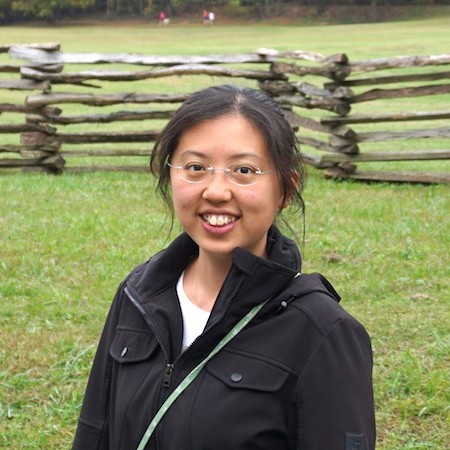Marc Abrahams's Blog, page 192
March 17, 2018
The PIZZA & POPCORN issue of the Annals of Improbable Research
The special Pizza & Popcorn Questions issue (vol. 24, no. 1) of the Annals of Improbable Research is now available.
The issue’s table of contents is online. And you can obtain, for a pittance, the full issue. The magazine is in splendid PDF form, packed with info yet lighter by far than a feather or a popcorn kernel.
“The Evolution of Popcorn” is a featured article. Lead author Russ Hodge will discuss the evolution of popcorn, when he joins the Ig Nobel EuroTour. Hodge will be part of the events in Berlin (March 19), Langen (March 21), and Heidelberg (March 23). Come see and hear him!

Emily Hofstetter joins Luxuriant Flowing Hair Club for Social Scientists
Emily Hofstetter has joined the Luxuriant Flowing, Former, or Facial Hair Club for Social Scientists (LFFFHCfSS). She says:
(LFFFHCfSS). She says:
While considering an academic career, I quickly realized that an ability to afford hair cuts was a necessary sacrifice, and have been practicing said asceticism ever since. As of 2018 my hair reaches my knees, and I can but pray my wisdom grows with the same dogged persistence. My locks hide tidily in a bun most days, allowing me to reveal my hair in a highly effective display whenever I wish to astonish students and emphasize the effects of Goffmanian front and performance in everyday life.
Emily Hofstetter, Ph.D., LFHCfS
Interactional Researcher
Loughborough University, Loughborough Leicestershire, UK
and University College, London, UK


March 15, 2018
Harvesting Midges for Fertilizer (research study)
In many parts of the world, e.g. N. W. Scotland, New Zealand, British Columbia and Nova Scotia (etc etc) there are almost incalculable numbers of pesky biting midges. A colossal nuisance to tourists and locals alike. But perhaps they could be put to good use – by capturing them and then using them as fertilizer? Researcher Amer Aldahi at the University of Sheffield, UK, believes so. In an experimental setup, he used a ‘Predator’ octanol-based midge collector and collected midges in prodigious amounts.
“
[…] wet midge biomass was evaluated here for its fertilizer potential. Such biomass could be applied to soils directly or after a period of composting and could be used alone or together with waste plant materials. One could envisage large amounts of such biomass being produced by individuals or perhaps council-run midge collectors (and co-operatives) and, as a result, relatively large amounts of material could be made locally available to farmers and the public. Transport costs might however, limit the wide-spread collection and use of midge biomass on an industrial scale. Certainly however, an individual octanol-based collector, when located in a high midge area, could supply useable nitrogen fertiliser to homes, allotments, and even small to medium sized fruit and commercial fruit and vegetable growers. The production costs of midge biomass could be offset by local authorities, hotels or other tourist locations, where the waste is produced when attempts are being made to reduce the tourist-nuisance potential of vast numbers of midges or mosquitoes.”
See: Section 5:11 of STUDIES ON MICROBES INCLUDING POTENTIAL HUMAN PATHOGENS FROM INSECTS AND OTHER INVERTEBRATES. PhD thesis, ALDahi, Amer (2017) University of Sheffield, UK.
Note: The midge mountain photo is provided courtesy of MidgeBusters of Dunoon, Argyll, Scotland, from whom you can purchase a Predator.

March 14, 2018
Acoustical Analysis of Shouting Into the Wind
The physics of shouting into the wind are now slightly better plumbed.
Details emerge in the study “Effects of flow gradients on directional radiation of human voice,” Ville Pulkki [pictured here, performing the experiment], Timo Lähivaara, and Ilkka Huhtakallio, The Journal of the Acoustical Society of America, vol. 143, no. 2, 2018, pp. 1173-1181. (Thanks to Lauri Savioja for bringing this to our attention.) The authors, at Aalto University and the University of Eastern Finland, report:
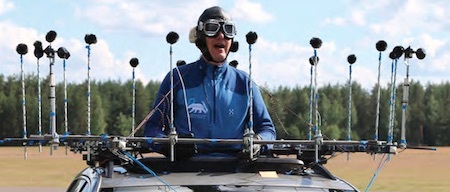
“In voice communication in windy outdoor conditions, complex velocity gradients appear in the flow field around the source, the receiver, and also in the atmosphere. It is commonly known that voice emanates stronger towards the downstream direction when compared with the upstream direction. In literature, the atmospheric effects are used to explain the stronger emanation in the downstream direction. This work shows that the wind also has an effect to the directivity of voice also favouring the downstream direction. The effect is addressed by measurements and simulations. Laboratory measurements are conducted by using a large pendulum with a loudspeaker mimicking the human head, whereas practical measurements utilizing the human voice are realized by placing a subject through the roof window of a moving car.”
This video shows the road work:

March 12, 2018
SIL e-Books – the bees’ knees for rhyming jingles (linguistics study)
If you’re after in-depth information about hanky panky, tittle tattle, or even argy bargy then where better to look than the pages of SIL e-Books ? In particular, chapter 16 of ‘A Mosaic of languages and cultures: studies celebrating the career of Karl J. Franklin*‘ – ‘Helter skelter and ñugl ñagl: English and Kalam Rhyming Jingles and the Psychic Unity of Mankind’
 Wherein Professor Andrew Pawley BA (NZ), MA, PhD (University of Auckland), FRSNZ, FAHA (Department of Linguistics College of Asia & the Pacific, Australian National University) examines English rhyming jingles such as dilly dally, rumpy pumpy, hocus pocus, nitty gritty and topsy-turvy.
Wherein Professor Andrew Pawley BA (NZ), MA, PhD (University of Auckland), FRSNZ, FAHA (Department of Linguistics College of Asia & the Pacific, Australian National University) examines English rhyming jingles such as dilly dally, rumpy pumpy, hocus pocus, nitty gritty and topsy-turvy.
He then compares them with those of Kalam, a language spoken by about 20,000 people living in the Bismarck and Schrader Ranges in SW Madang Province, Papua New Guinea. For example ;
Godey Bodey (to swing round like a propellor)
Gadal Badl (higgledy piggledy)
Cnaŋ Mnaŋ (to wear strings of beads that cross the chest and back diagonally) and, of course,
ñugl ñagl (resound, of the evening chorus of insects, frogs, etc. in the grasslands).
* The entire e-Bbook (476 pages) may be downloaded, for scholarly purposes only, from here.
Note: The bees’ knees means roughly the same as “the cat’s pajamas” i.e. the height of excellence.
BONUS (musical) : Rootin’ tootin’ Hurdy Gurdy music from Andrey Vinogradov.

March 10, 2018
A Dramatic Non-Reading of William McGonagall’s Bad Poetry
A special dramatic non-reading of the poetry of William McGonagall was a last-minute addition to the Ig Nobel Show at Imperial College on Friday night, March 9, 2018.
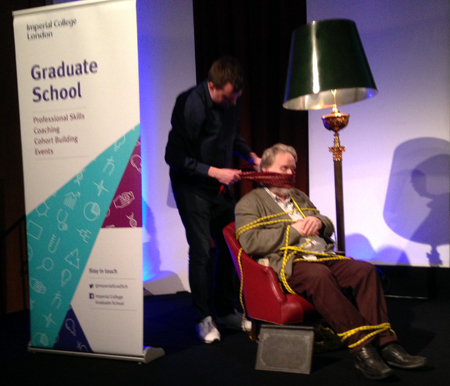
McGonagall is famed as the worst poet ever to write in the English language. Ig Nobel shows have, time and again, included dramatic readings of his work. (The high point was the group reading, on a train crossing the Tay Bridge, of McGonagall’s “Tay Bridge Disaster”—a poem lamenting the tragic collapse of that bridge.
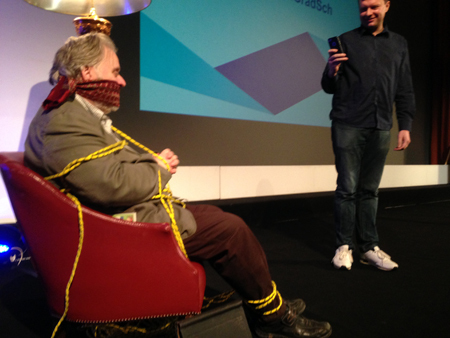
Many of the Ig Nobel shows we have done at Imperial College have included a dramatic reading of McGonagall poems, performed by Andrew J.T. George, whose persistence on many occasions induced the successful booing and halting of the reading. Professor George was unable to attend this year’s show at Imperial College. Therefore, we sought an able substitute performer—a performer capable of delivering a specially restrained performance: noted author and raconteur Stevyn Colgan.
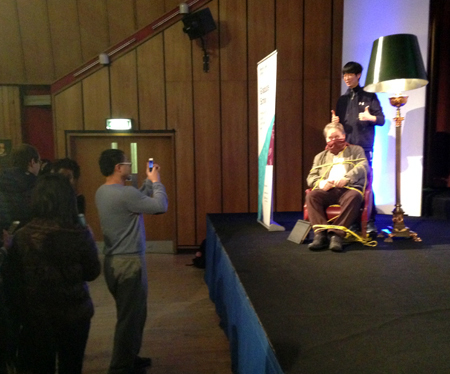
Colgyn performed a dramatic non-reading of several poems by William McGonagall, in the midsts of spending the entire evening on stage at Imperial College, gagged, and bound to a chair.
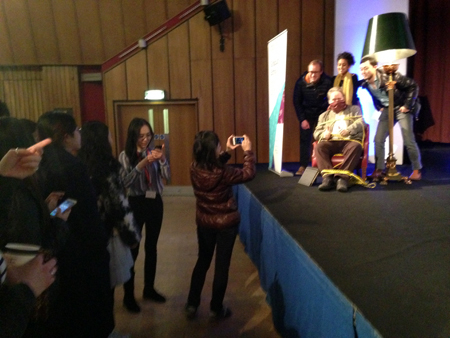
The entire Ig Nobel show began, proceeded, and finished during Colgan’s evening-long on-stage tenure. Here are photos of that performance by Stevyn Colgan. Many audience members clambered onto the stage to have their photographs taken with Colgan.
The Ig Nobel Show at Imperial College was the first event in the Ig Nobel EuroTour. The tour will also include shows in the UK, Austria, Germany, Switzerland, Sweden, Denmark, and other countries.

March 8, 2018
Recent progress in sham acupuncture needles
A new ‘sham’ (i.e. fake) needle has been developed for use in electro-acupuncture trials – one which has neither a needle nor a valid electrical connection. [See diagram].
It’s described by Dr Yiu Ming Wong of the Health Science Unit (PEC), Hong Kong Physically Handicapped & Able Bodied Association, Kowloon, Hong Kong, in a letter for Acupuncture in Medicine, February 2018, Volume 36, Issue 1, entitled : ‘Evaluating blinding effectiveness of a novel Ryodoraku sham needle device’. In an experimental setup, 95% of participants reported that they felt they had been treated with a real needle. Dr Wong says that the new sham needle may help determine the efficacy of Ryodoraku electro-acupuncture (REA) in future clinical trials.
A supplementary video (in .mp4 format) which shows the sham needle in use (or rather not in use) is available here for download.
Also see previous post : Sham acupuncture needles – how do they perform?

March 7, 2018
Some Kinds of Coffee Are More Fragrantly Attractive to Ants
Humans are not the only animals that (in many cases) are attracted by the smell of coffee. This study focuses on ants’ attraction to coffee smells:
“Olfactory behavior and response of household ants (Hymenoptera) to different types of coffee odor: A coffee-based bait development prospect,” Abdul Hafiz Ab Majid, Hamady Dieng, Siti Salbiah Ellias, Faezah Syukriah Sabtu, Abd Hafis Abd Rahim, and Tomomitsu Satho, Journal of Asia-Pacific Entomology, vol. 21, no. 1, March 2018, pp. 46-51.
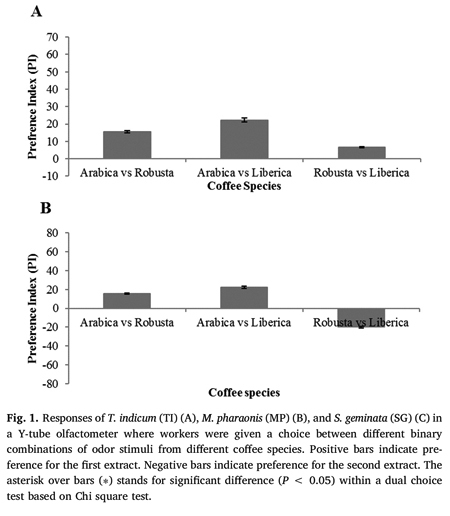
The authors, at Universiti Sains Malaysia, Malaysia, Universiti Malaysia Sarawak, Malaysia, and Fukuoka University, Japan, report:
In a series of Y-tube olfactometer bioassays, we examined the behavioral responses of Tapinoma indicum (TI), Monomorium pharaonis (MP) and Solenopsis geminata (SG) to various coffee-induced odor stimuli, comprised of extracts from Arabica, Robusta and Liberica….
Arabica extract mixed with sugar (S) elicited a significant attraction from workers of all three species in a balanced competition with either unsweetened Arabica extract or water. These results indicated that coffee, particularly Arabica, was attractive to the foragers of TI, MP and SG…
(Thanks to Neil Martin for bringing this to our attention.)

March 6, 2018
Video of a historic attempt to reproduce wombat, quasi-cubic poo
This historic (2998) video by Robyn Lawrence documents an attempt to understand and reproduce the forces and constraints that allow or induce wombats to produce somewhat cubic excrement. (Thanks to Pat Kight for bringing it to our attention.)
Currently, Patricia Yang [pictured here], a graduate student at Georgia Tech, who shared the 2015 Ig Nobel Physics Prize, for testing the biological principle that nearly all mammals empty their bladders in about 21 seconds (plus or minus 13 seconds)—is working on the same general question.

The Ig Nobel EuroTour begins in London
The 2018 Ig Nobel Spring EuroTour begins this week—meandering to England, Austria, Germany, Switzerland, Spain, Sweden, and Denmark.
The first show is in London:
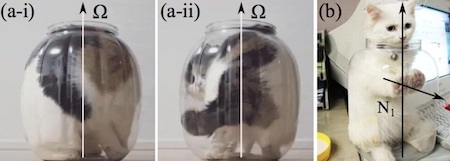
March 9, Friday, 6:00 pm— Imperial College London, UK—in the Sherfield Building at the South Kensington Campus, in the Great Hall. With:
Marc Abrahams , founder of the Ig Nobel Prize ceremony
Charles Foster — Ig Nobel Biology Prize winner (living in the wild as, at different times, a badger, an otter, a deer, a fox, and a bird)
Matteo Martini , Ig Nobel Cognition Prize winner (demonstrating that many identical twins cannot tell themselves apart visually)
Tom Williamson (creator of the web site WisdomofChopra, which contributed to the Ig Nobel Prize winning study “On the reception and detection of pseudo-profound bullshit“)
Marc-Antoine Fardin — Ig Nobel Physics Prize winner (using fluid dynamics to probe the question “Can a Cat Be Both a Solid and a Liquid?”)
TICKETS: The Imperial College show is fully booked. But don’t despair! Likely some tickets will become available at the last minute, if a few ticket-holders don’t turn up. If you’ve an ounce of optimism, come to the Great Hall fifteen minutes before show time, and maybe, maybe, maybe you’ll get lucky!
The full Ig Nobel EuroTour schedule is on our events page.

Marc Abrahams's Blog
- Marc Abrahams's profile
- 14 followers




